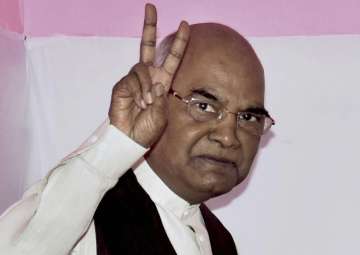Presidential elections 2017: Calculations show a certain win for Ram Nath Kovind against opposition candidate Meira Kumar
What makes the presidential election complex is the mathematics involved in it. The electoral college comprises of all elected MPs and MLAs, whose vote has a defined weightage depending on size of the population.

Despite the office of the President of India envisaged in the Constitution as apolitical in nature, the presidential election is a complicated exercise with several mathematical as well as political equations that come into play. The selection of Bihar Governor Ram Nath Kovind, as BJP’s presidential candidate and opposition parties decision to field former Lok Sabha Speaker Meira Kumar, has somehow further complicated the political equation as parties are finding it difficult to choose between the two Dalit leader. The Bharatiya Janta Party (BJP) is confident that it would succeed in placing one of its own leaders, with an RSS background, to the highest office in the country. It would, however, require the BJP to seek support from outside the National Democratic Alliance (NDA).
What makes the presidential election complex is the mathematics involved in it. The electoral college comprises of all elected MPs and MLAs, whose vote has a defined weightage depending on size of the population.
Here is how the weightage of voters in Presidential election is calculated:
Calculating the value of MLA’s vote:
The value of an MLA’s vote is calculated by dividing the population of the state to which the members belong as per 1971 Census by the total number of elected members of the that state’s Assembly and then dividing the result by 1000. By this equation, an MLA of a populous state carries more value to his or her vote than a member of an Assembly of less populous state.
Let us take Maharashtra for example:
Number of elected member in Maharashtra Assembly – 288
Population of UP as per 1971 Census – 5,04,12,235
Value of each MLA - 5,04,12,235/288x1000 = 175
Total value of votes of state Assembly: 50,400
Total value of all the votes from all states is: 5,49,495
Calculating the value of MP’s vote for Presidential Election 2017:
The value of all the votes from all states is divided by the total number of elected members in both Houses of the Parliament to calculate the value of vote of one MP. Nominated members are not eligible to vote in the presidential election.
Total number of MPs (Lok Sabha+Rajya Sabha): 543+233=776
Total value of all votes from all the states: 5,49,495
Value of one vote of an MP: 5,49,495/776=708
Total value of votes of 776 members of parliament = 708 x 776 = 5,49,408
Total value of votes of 4896 electors for the presidential election 2017 = 5,49,495 + 5,49,408 = 10,98,903
Presidential Poll 2017 BJP’s strength in terms of numbers
The provisions of the anti-defection law are not applicable to the Presidential election and members are free to vote a candidate of their choosing as they are not bound by any party whips. Secret ballot ensures fair polling. However, members are expected to vote as per their party’s directions. Considering this, the strength of political parties in state assemblies and Parliament is factored in while planning the presidential polls.
The NDA, led by the BJP, has 5,37,683 votes and this is including the Shiv Sena. The Maharashtra-based party has not yet announced its support for Ram Nath Kovind so would be safe for the BJP to devise a strategy excluding Shiv Sena’s votes.
Shiv Sena’s strength in Electoral College:
Lok Sabha
MPs: 18
Value of all votes: 18x708=12,744
Rajya Sabha
MPs: 3
Value of all votes: 3 x 708= 2,124
Maharashtra Assembly
MLAs: 63
Value of all votes:63 x 175=11,025
Total strength of Shiv Sena’s Electoral College: 12,774+2,124+11,025=25,893
Thus, the NDA’s strength excluding that of the Shiv Sena votes is 5,11,790.
BJP, with 282 Lok Sabha members and 56 Rajya Sabha members, has total weightage of 2,39,304 in Parliament. Totalling votes from all state assemblies, BJP has total 4,42,117 votes in the electoral college.
A candidate would need 1 more than half of the total votes polled to secure a win in the Presidential election. Assuming that all votes are polled, a candidate would at least need 5,49,451.5+1 votes to win the election. The NDA, thus, would need to garner support from other parties.
The Biju Janata Dal (BJD), Telangana Rashtra Samithi (TRS) and YSR Congress Party (YSRCP) have already declared their support for Kovind.
Here is how these parties stand in terms of votes in the electoral college:
BJD-32,892
TRS-22TRS-22,048
YSRCP-16,848
Total-71,788
Thus, the candidature of Ram Nath Kovind, as of now, has total support of 8,83,578 votes which is well above the 50 per cent of total eligible votes.
If all goes well for the BJP in the next one month, Ram Nath Kovind will almost certainly emerge as a winner on July 20, 2017 when India gets its new President at the Rashtrapati Bhavan.